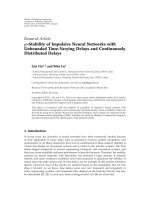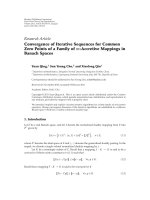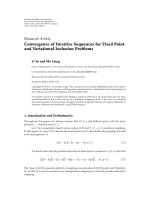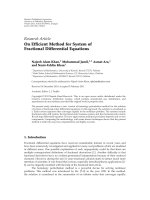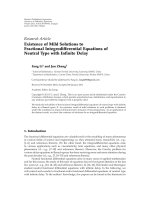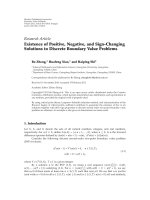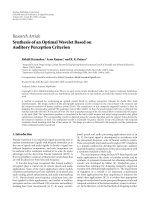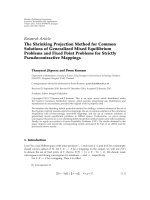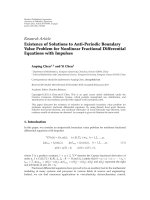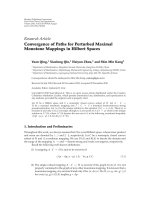Báo cáo hóa học: " Research Article Convergence of Iterative Sequences for Common Zero Points of a Family of m-Accretive Mappings in Banach Spaces" pdf
Bạn đang xem bản rút gọn của tài liệu. Xem và tải ngay bản đầy đủ của tài liệu tại đây (513.25 KB, 12 trang )
Hindawi Publishing Corporation
Fixed Point Theory and Applications
Volume 2011, Article ID 216173, 12 pages
doi:10.1155/2011/216173
Research Article
Convergence of Iterative Sequences for Common
Zero Points of a Family of m-Accretive Mappings in
Banach Spaces
Yuan Qing,1 Sun Young Cho,2 and Xiaolong Qin1
1
2
Department of Mathematics, Hangzhou Normal University, Hangzhou 310036, China
Department of Mathematics, Gyeongsang National University, Jinju 660-701, Republic of Korea
Correspondence should be addressed to Sun Young Cho,
Received 21 November 2010; Accepted 8 February 2011
Academic Editor: Yeol J. Cho
Copyright q 2011 Yuan Qing et al. This is an open access article distributed under the Creative
Commons Attribution License, which permits unrestricted use, distribution, and reproduction in
any medium, provided the original work is properly cited.
We introduce implicit and explicit viscosity iterative algorithms for a finite family of m-accretive
operators. Strong convergence theorems of the iterative algorithms are established in a reflexive
Banach space which has a weakly continuous duality map.
1. Introduction
Let E be a real Banach space, and let J denote the normalized duality mapping from E into
∗
2E given by
J x
f ∈ E∗ : x, f
x
2
f
2
,
x ∈ E,
1.1
where E∗ denotes the dual space of E and ·, · denotes the generalized duality pairing. In the
sequel, we denote a single-valued normalized duality mapping by j.
Let K be a nonempty subset of E. Recall that a mapping f : K → K is said to be a
contraction if there exists a constant α ∈ 0, 1 such that
f x −f y
≤α x−y ,
∀x, y ∈ K.
1.2
Recall that a mapping T : K → K is said to be nonexpansive if
Tx − Ty ≤ x − y ,
∀x, y ∈ K.
1.3
2
Fixed Point Theory and Applications
A point x ∈ K is a fixed point of T provided T x x. Denote by F T the set of fixed points of T ,
that is, F T
{x ∈ K : T x x}. Given a real number t ∈ 0, 1 and a contraction f : C → C,
we define a mapping
f
Tt x
1 − t T x,
tf x
x ∈ K.
1.4
f
It is obviously that Tt is a contraction on K. In fact, for x, y ∈ K, we obtain
f
f
T t x − Tt y ≤ t f x − f y
1 − t Tx − Ty
≤ αt x − y
1−t
Tx − Ty
≤ αt x − y
1−t
x−y
1−t 1−α
1.5
x−y .
f
Let xt be the unique fixed point of Tt , that is, xt is the unique solution of the fixed point
equation
xt
tf xt
1 − t T xt .
1.6
A special case has been considered by Browder 1 in a Hilbert space as follows. Fix
u ∈ C and define a contraction St on K by
St x
1 − t T x,
tu
x ∈ K.
1.7
We use zt to denote the unique fixed point of St , which yields that zt
Browder 1 proved the following theorem.
tu
1 − t T zt . In 1967,
Theorem B. In a Hilbert space, as t → 0, zt converges strongly to a fixed point of T , that is, closet
to u, that is, the nearest point projection of u onto F T .
In 2 , Moudafi proposed a viscosity approximation method which was considered by
many authors 2–8 . If H is a Hilbert space, T : K → K is a nonexpansive mapping and
f : K → K is a contraction, he proved the following theorems.
Theorem M 1. The sequence {xn } generated by the following iterative scheme:
xn
1
1
n
T xn
n
1
n
1.8
f xn
converges strongly to the unique solution of the variational inequality
x∈F T ,
such that
I − f x, x − x ≤ 0,
where { n } is a sequence of positive numbers tending to zero.
∀x ∈ F T ,
1.9
Fixed Point Theory and Applications
3
Theorem M 2. With and initial z0 ∈ C defined the sequence {zn } by
zn
1
1
1
n
T zn
n
1
n
1.10
f zn .
Suppose that limn → ∞ n 0, and ∞ 1
∞ and limn → ∞ |1/ n 1 − 1/ | 0. Then, {zn } converges
n
strongly to the unique solution of the unique solutions of the variational inequality
x∈F T ,
such that
I − f x, x − x ≤ 0,
∀x ∈ F T .
1.11
Recall that a possibly multivalued operator A with domain D A and range R A in
E is accretive if for each xi ∈ D A and yi ∈ Axi i 1, 2 , there exists a j x2 − x1 ∈ J x2 − x1
such that
y2 − y1 , j x2 − x1
An accretive operator A is m-accretive if R I
of A is denoted by N A . Hence,
N A
≥ 0.
1.12
rA
{z ∈ D A : 0 ∈ A z }
E for each r > 0. The set of zeros
A−1 0 .
1.13
I rA −1 . Note that if A
For each r > 0, we denote by Jr the resolvent of A, that is, Jr
N A , for all r > 0. We also
is m-accretive, then Jr : E → E is nonexpansive and F Jr
1/r I − Jr . It is known that Jr is
denote by Ar the Yosida approximation of A, that is, Ar
a nonexpansive mapping from E to D A .
Recently, Kim and Xu 9 and Xu 10 studied the sequence generated by the following
iterative algorithm:
x0 ∈ K,
xn
1
αn u
1 − αn Jrn xn ,
n ≥ 0,
1.14
where {αn } is a real sequence 0, 1 and Jrn
I rA −1 . They obtained the strong convergence
of the iterative algorithm in the framework of uniformly smooth Banach spaces and reflexive
Banach space, respectively. Xu 10 also studied the following iterative algorithm by viscosity
approximation method
x0 ∈ K,
xn
1
αn f xn
1 − αn T xn ,
n ≥ 0,
1.15
where {αn } is a real sequence 0, 1 , f : K → K is a contractive mapping, and T : K → K is
a nonexpansive mapping with a fixed point. Strong convergence theorems of fixed points are
obtained in a uniformly smooth Banach space; see 10 for more details.
Very recently, Zegeye and Shahzad 11 studied the common zero problem of a family
of m-accretive mappings. To be more precise, they proved the following result.
Theorem ZS. Let E be a strictly convex and reflexive Banach space with a uniformly Gˆ teaux
a
differentiable norm, K a nonempty, closed, convex subset of E, and Ai : K → E i 1, 2, . . . , r
4
Fixed Point Theory and Applications
r
i 1
a family of m-accretive mappings with
the algorithm
xn
1
N Ai / ∅. For any u, x0 ∈ K, let {xn } be generated by
1 − αn Sr xn ,
: αn u
n ≥ 0,
1.16
where {αn }is a real sequence which satisfies the following conditions: limn → ∞ αn 0; ∞ 0 αn ∞;
n
∞
0 and Sr : a0 I a1 JA1 a2 JA2 · · · ar JAr
n 0 |αn − αn−1 | < ∞ or limn → ∞ |αn − αn−1 |/αn
with JAi : I Ai −1 for 0 < ai < 1 for i
0, 1, 2, . . . , r and r 0 ai
1. If every nonempty,
i
closed, bounded convex subset of E has the fixed point property for a nonexpansive mapping, then
{xn } converges strongly to a common solution of the equations Ai x 0 for i 1, 2, . . . , r.
In this paper, motivated by the recent work announced in 3, 5, 9, 11–20 , we consider
the following implicit and explicit iterative algorithms by the viscosity approximation
method for a finite family of m-accretive operators {A1 , A2 , . . . , Ar }. The algorithms are as
following:
x0 ∈ K,
x0 ∈ K,
xn
xn
1.17
n ≥ 0,
1 − αn Sr xn ,
αn f xn
1
n ≥ 0,
1 − αn Sr xn ,
αn f xn
1.18
where Sr : a0 I a1 JA1 a2 JA2 · · · ar JAr with 0 < ai < 1 for i 0, 1, 2, . . . , r, r 0 ai 1 and
i
{αn } is a real sequence in 0, 1 . It is proved that the sequence {xn } generated in the iterative
algorithms 1.17 and 1.18 converges strongly to a common zero point of a finite family of
m-accretive mappings in reflexive Banach spaces, respectively.
2. Preliminaries
The norm of E is said to be Gˆ teaux differentiable and E is said to be smooth if
a
x
lim
t→0
ty − x
t
2.1
exists for each x, y in its unit sphere U {x ∈ E : x
1}. It is said to be uniformly Fr´ chet
e
differentiable and E is said to be uniformly smooth if the limit in 2.1 is attained uniformly for
x, y ∈ U × U.
A Banach space E is said to be strictly convex if, for ai ∈ 0, 1 , i 1, 2, . . . , r, such that
r
ai 1,
i 1
a1 x1
1, i
with xi
have that, if
a2 x2
···
ar xr < 1,
∀xi ∈ E, i
1, 2, . . . , r,
2.2
1, 2, . . . , r, and xi / xj for some i / j. In a strictly convex Banach space E, we
x1
for xi ∈ E, ai ∈ 0, 1 , i
x2
···
a1 x1
xr
1, 2, . . . , r, where
r
i 1
ai
a2 x2
1, then x1
···
x2
ar xr
···
2.3
xr see 21 .
Fixed Point Theory and Applications
5
Recall that a gauge is a continuous strictly increasing function ϕ : 0, ∞ → 0, ∞
such that ϕ 0
0 and ϕ t → ∞ as t → ∞. Associated to a gauge ϕ is the duality map
Jϕ : E → E∗ defined by
Jϕ x
x∗ ∈ E∗ : x, x∗
x ϕ x , x∗
ϕ x
,
x ∈ E.
2.4
Following Browder 22 , we say that a Banach space E has a weakly continuous duality map if
there exists a gauge ϕ for which the duality map Jϕ x is single valued and weak-to-weak∗
sequentially continuous i.e., if {xn } is a sequence in E weakly convergent to a point x, then
the sequence Jϕ xn converges weakly∗ to Jϕ x . It is known that lp has a weakly continuous
t for all
duality map for all 1 < p < ∞ with the gauge ϕ t
tp−1 . In the case where ϕ t
t > 0, we write the associated duality map as J and call it the normalized duality map. Set
t
ϕ τ dτ,
∀t ≥ 0,
2.5
∂Φ x ,
∀x ∈ E,
2.6
Φ t
0
then
Jϕ x
where ∂ denotes the subdifferential in the sense of convex analysis. It also follows from 2.5
that Φ is convex and Φ 0
0.
In order to prove our main results, we also need the following lemmas.
The first part of the next lemma is an immediate consequence of the subdifferential
inequality, and the proof of the second part can be found in 23 .
Lemma 2.1. Assume that E has a weakly continuous duality map Jϕ with the gauge ϕ.
i For all x, y ∈ E and jϕ x
Φ
x
y ∈ Jϕ x
≤Φ x
y
In particular, for x, y ∈ E and j x
x
y
y , there holds the inequality
2
y, jϕ x
y ∈J x
≤ x
2
y .
2.7
y ,
2 y, j x
y .
2.8
J x .
2.9
ii For λ ∈ R and for nonzero x ∈ E,
Jϕ λx
sgn λ
ϕ |λ|/ x
x
Lemma 2.2 see 24 . Let E be a Banach space satisfying a weakly continuous duality map, let K be
a nonempty, closed, convex subset of E, and let T : K → K be a nonexpansive mapping with a fixed
point. Then, I − T is demiclosed at zero, that is, if {xn } is a sequence in K which converges weakly to
x and if the sequence { I − T xn } converges strongly to zero, then x T x.
6
Fixed Point Theory and Applications
Lemma 2.3 see 11 . Let K be a nonempty, closed, convex subset of a strictly convex Banach space
E. Let Ai : K → E, i 1, 2, . . . , r, be a family of m-accretive mappings such that r 1 N Ai / ∅.
i
Let a0 , a1 , a2 , . . . , ar be real numbers in 0, 1 such that r 0 ai 1 and Sr : a0 I a1 JA1 a2 JA2
i
r
· · · ar JAr , where JAi : I Ai −1 . Then, Sr is nonexpansive and F Sr
i 1 N Ai .
∞
n 0 {αn }
Lemma 2.4 see 25 . Let
condition
αn
1
be a sequence of nonnegative real numbers satisfying the
≤ 1 − γn αn
n ≥ 0,
γn σn ,
2.10
where {γn }∞ 0 ⊂ 0, 1 and {σn }∞ 0 such that
n
n
i limn → ∞ γn
∞
n 0 γn
0 and
∞,
∞
n 0
ii either lim supn → ∞ σn ≤ 0 or
Then
{αn }∞ 0
n
|γn σn | < ∞.
converges to zero.
3. Main Results
Theorem 3.1. Let E be a strictly convex and reflexive Banach space which has a weakly continuous
duality map Jϕ with the gauge ϕ. Lek K be a nonempty, closed, convex subset of E and f : K → K
a contractive mapping with the coefficient α 0 < α < 1 . Let {Ai }r 1 : K → E be a family of mi
accretive mappings with r 1 N Ai / ∅. Let JAi : I Ai −1 , for each i 1, 2, . . . , r. For any x0 ∈ K,
i
let {xn } be generated by the algorithm 1.17 , where Sr : a0 I a1 JA1 a2 JA2 · · · ar JAr with
0 < ai < 1 for i 0, 1, 2, . . . , r, r 0 ai 1 and {αn } is a sequence in 0, 1 . If limn → ∞ xn − Sr xn
i
0, then {xn } converges strongly to a common solution x∗ of the equations Ai x 0 for i 1, 2, . . . , r,
which solves the following variational inequality:
I − f x∗ , J p − x∗
≥ 0,
p ∈ F Sr .
3.1
Proof. From Lemma 2.3, we see that Sr is a nonexpansive mapping and
r
F Sr
N Ai / ∅.
3.2
i 1
r
i 1
Notice that Φ is convex. From Lemma 2.1, for any fixed p ∈ F Sr
Φ
xn − p
Φ
αn f xn − f p
≤Φ
αn f xn − f p
≤ 1 − αn 1 − α Φ
αn f p − p
1 − αn Sr xn − p
1 − αn Sr xn − p
xn − p
N Ai , we have
αn f p − p, Jϕ xn − p
αn f p − p, Jϕ xn − p ,
3.3
which in turn implies that
Φ
xn − p
≤
1
f p − p, Jϕ xn − p .
1−α
3.4
Fixed Point Theory and Applications
7
Note that 3.4 actually holds for all duality maps Jϕ ; in particular, if we take the normalized
duality J in which case, we have Φ r
1/2 r 2 , then we get
xn − p
2
≤
2
f p − p, J xn − p
1−α
3.5
2
f p −p .
1−α
3.6
that is,
xn − p ≤
This implies that the sequence {xn } is bounded. Now assume that x∗ is a weak limit point of
{xn } and a subsequence {xnj } of {xn } converges weakly to x∗ . Then, by Lemma 2.2, we see
that x∗ is a fixed point of Sr . Hence, x∗ ∈ r 1 N Ai . In 3.4 , replacing xn with xnj and p
i
with x∗ , respectively, and taking the limit as j → ∞, we obtain from the weak continuity of
the duality map Jϕ that
lim Φ
j →∞
xnj − x∗
≤ 0.
3.7
Hence, we have xnj → x∗ .
Next, we show that x∗ solves the variation inequality 3.1 . For p ∈ F Sr
we obtain
Φ
xn − p
Φ
αn xn − p
αn f xn − xn
≤Φ
αn xn − p
≤Φ
xn − p
r
i 1
N Ai ,
1 − αn Sr xn − p
1 − αn Sr xn − p
αn f xn − xn , Jϕ xn − p
3.8
αn f xn − xn , Jϕ xn − p ,
which implies that
xn − f xn , Jϕ xn − p
≤ 0.
3.9
Replacing xn with xnj in 3.9 and passing through the limit as j → ∞, we conclude that
x ∗ − f x ∗ , Jϕ x ∗ − p
lim xnj − f xnj , Jϕ xnj − p
j →∞
≤ 0.
3.10
It follows from Lemma 2.1 that J x∗ − p is a positive-scalar multiple of Jϕ x∗ − p . We,
therefore, obtain that x∗ is a solution to 3.1 .
Finally, we prove that the full sequence {xn } actually converges strongly to x∗ . It
suffices to prove that the variational inequality 3.1 can have only one solution. This is an
r
easy consequence of the contractivity of f. Indeed, assume that both u ∈ F Sr
i 1 N Ai
r
N Ai are solutions to 3.1 . Then, we see that
and v ∈ F Sr
i 1
I − f u, J u − v
≤ 0,
I − f v, J v − u
≤ 0.
3.11
8
Fixed Point Theory and Applications
Adding them yields that
I − f u − I − f v, J u − v
≤ 0.
3.12
This implies that
0≥
which guarantees u
I − f u − I − f v, J u − v
≥ 1−α u−v
2
≥ 0,
3.13
v. So, 3.1 can have at most one solution. This completes the proof.
Next, we shall consider the explicit algorithm 1.18 which is rephrased below, the
initial guess z0 ∈ K is arbitrary and
zn
1 − αn Sr zn ,
αn f zn
1
n ≥ 0.
3.14
We need the strong convergence of the implicit algorithm 1.17 to prove the strong
convergence of the explicit algorithm 3.14 .
Theorem 3.2. Let E be a strictly convex and reflexive Banach space which has a weakly continuous
duality map Jϕ with the gauge ϕ. Lek K be a nonempty, closed, convex subset of E and f : K → K a
contractive mapping. Let {Ai }r 1 : K → E be a family of m-accretive mappings with r 1 N Ai / ∅.
i
i
Let JAi : I Ai −1 for each i 1, 2, . . . , r. For any x0 ∈ K, let {xn } be generated by the algorithm
0, 1, 2, . . . , r,
1.18 , where Sr : a0 I a1 JA1 a2 JA2 · · · ar JAr with 0 < ai < 1 for i
r
1, and {αn } is a sequence in 0, 1 which satisfies the following conditions: limn → ∞ αn 0
i 0 ai
and ∞ 0 αn ∞. Assume also that
n
i limn → ∞ zn − Sr zn
0,
ii {xn } converges strongly to x∗ ∈
implicity algorithm 1.17 .
r
i 1
N Ai , where {xn } is the sequence generated by the
Then, {zn } converges strongly to x∗ , which solves the variational inequality 3.1 .
Proof. From Lemma 2.3, we obtain that Sr is a nonexpansive mapping and
r
F Sr
N Ai / ∅.
3.15
i 1
We observe that {zn }∞ 0 is bounded. Indeed, take p ∈ F Sr
n
zn
1
−p
≤ max
f p −p
f zn − f p
1 − αn 1 − α
zn − p ,
N Ai and notice that
1 − αn Sr zn − p
αn f zn − p
≤ αn
r
i 1
zn − p
1 − αn
αn f p − p
f p −p
1−α
.
zn − p
3.16
Fixed Point Theory and Applications
9
By simple inductions, we have
zn − p ≤ max
z0 − p ,
p−f p
1−α
,
3.17
which gives that the sequence {zn } is bounded, so are {f zn } and {Sr zn }. From 1.17 , we
have
xm − zn
1 − αm Sr xm − zn .
αm f xm − zn
3.18
This implies that
2
2
≤ 1 − αm
2
Sr xm − zn
1 − αm
xm − zn
2
Sr xm − Sr zn
2αm f xm − zn , J xm − zn
Sr zn − zn
2
2αm f xm − xm , J xm − zn
2αm xm − zn , J xm − zn
≤ 1 − αm
2
xm − zn
2αm xm − zn
≤ 1
α2
m
Sr zn − zn
2
2αm f xm − xm , J xm − zn
3.19
2
xm − zn
2
Sr zn − zn
Sr zn − zn
2 xm − zn
2αm f xm − xm , J xm − zn ,
which in turn implies that
f xm − xm , J zn − xm
≤ αm xm − zn
It follows from limn → ∞ Sr zn − zn
2
Sr zn − zn
αm
Sr zn − zn
2 xm − zn .
3.20
0 that
lim sup f xm − xm , J zn − xm
n→∞
≤ lim sup αm xm − zn 2 .
n→∞
3.21
From the assumption xm → x∗ and the weak continuity of Jϕ imply that,
J xm − zn
xm − zn
ϕ xm − zn
Jϕ xm − zn
x∗ − zn
ϕ x∗ − zn
Jϕ x∗ − zn
J x∗ − zn .
3.22
Letting m → ∞ in 3.21 , we obtain that
lim sup f x∗ − x∗ , J zn − x∗
n→∞
≤ 0.
3.23
10
Fixed Point Theory and Applications
Finally, we show the sequence {zn } converges stongly to x∗ . Observe that
zn
1
− x∗
αn f zn − x∗
1 − αn Sr zn − x∗ .
3.24
It follows from Lemma 2.1 that
1
− x∗
2
≤ 1 − αn
2
Sr zn − x∗
≤ 1 − αn
zn
2
zn − x∗
2
2αn f zn − x∗ , J zn
2
2αn f zn − f x∗ , J zn
2αn f x∗ − x∗ , J zn
≤ 1 − αn
2
zn − x∗
2
1
1
1
− x∗
− x∗
αn α
2αn f x∗ − x∗ , J zn
− x∗
1
3.25
zn − x∗
2
zn
− x∗
1
2
− x∗ ,
which yields that
zn
∗
1−x
2
≤
1 − αn 2 ααn
zn − x∗
1 − ααn
2αn
f x∗ − x∗ , J zn
1 − ααn
2
≤ 1−
2αn 1 − α
1 − ααn
zn − x∗
2
≤ 1−
2αn 1 − α
1 − ααn
zn − x∗
2
×
1
f x∗ − x∗ , J zn
1−α
1
1
2αn
f x∗ − x∗ , J zn
1 − ααn
− x∗
1
− x∗
Mα2
n
2αn 1 − α
1 − ααn
− x∗
M
1 − ααn αn
,
2 1−α
3.26
where M is a appropriate constant such that M ≥ supn≥0 { zn − x∗ 2 / 1 − ααn }. In view of
Lemma 2.4, we can obtain the desired conclusion easily. This completes the proof.
As an application of Theorems 3.1 and 3.2, we have the following results for a single
mapping.
Corollary 3.3. Let E be a reflexive Banach space which has a weakly continuous duality map Jϕ with
the gauge ϕ. Lek K be a nonempty, closed, convex subset of E and f : K → K a contractive mapping
with the coefficient α 0 < α < 1 . Let A : K → E be a m-accretive mapping with N A / ∅. Let
JA : I A −1 . For any x0 ∈ K, let {xn } be generated by the following iterative algorithm:
x0 ∈ K,
xn
αn f xn
1 − αn JA xn ,
Then, {xn } converges strongly to a solution of the equations Ax
n ≥ 0.
3.27
0.
Corollary 3.4. Let E be a reflexive Banach space which has a weakly continuous duality map Jϕ with
gauge ϕ. Let K be a nonempty, closed, convex subset of E and f : K → K a contractive mapping.
Fixed Point Theory and Applications
11
Let A : K → E be a m-accretive mappings with N A / ∅. Let JA :
{xn } be generated by the following algorithm:
x0 ∈ K,
xn
1
αn f xn
1 − αn JA xn ,
I
A
−1
. For any x0 ∈ K, let
n ≥ 0,
where {αn } is a sequence in 0, 1 which satisfies the following conditions: limn → ∞ αn
∞
∞. Also assume that
n 0 αn
i limn → ∞ zn − S1 zn
3.28
0 and
0,
ii {xn } converges strongly to x∗ , where {xn } is the sequence generated by the implicity scheme
3.27 and x∗ ∈ N A .
Then, the sequence {zn } generated by the following iterative algorithm
zn
1
αn f zn
1 − αn JA zn ,
converges strongly to a solution x∗ of the equation Ax
n≥0
3.29
0.
References
1 F. E. Browder, “Convergence of approximants to fixed points of nonexpansive non-linear mappings
in Banach spaces,” Archive for Rational Mechanics and Analysis, vol. 24, pp. 82–90, 1967.
2 A. Moudafi, “Viscosity approximation methods for fixed-points problems,” Journal of Mathematical
Analysis and Applications, vol. 241, no. 1, pp. 46–55, 2000.
3 Y. J. Cho and X. Qin, “Viscosity approximation methods for a family of m-accretive mappings in
reflexive Banach spaces,” Positivity, vol. 12, no. 3, pp. 483–494, 2008.
4 Y. J. Cho, S. M. Kang, and X. Qin, “Some results on k-strictly pseudo-contractive mappings in Hilbert
spaces,” Nonlinear Analysis: Theory, Methods & Applications, vol. 70, no. 5, pp. 1956–1964, 2009.
5 Y. J. Cho, S. M. Kang, and X. Qin, “Approximation of common fixed points of an infinite family of
nonexpansive mappings in Banach spaces,” Computers & Mathematics with Applications, vol. 56, no. 8,
pp. 2058–2064, 2008.
6 L.-C. Ceng, H.-K. Xu, and J.-C. Yao, “The viscosity approximation method for asymptotically
nonexpansive mappings in Banach spaces,” Nonlinear Analysis: Theory, Methods & Applications, vol.
69, no. 4, pp. 1402–1412, 2008.
7 X. Qin, Y. J. Cho, and S. M. Kang, “Viscosity approximation methods for generalized equilibrium
problems and fixed point problems with applications,” Nonlinear Analysis: Theory, Methods &
Applications, vol. 72, no. 1, pp. 99–112, 2010.
8 H.-K. Xu, “Viscosity approximation methods for nonexpansive mappings,” Journal of Mathematical
Analysis and Applications, vol. 298, no. 1, pp. 279–291, 2004.
9 T.-H. Kim and H.-K. Xu, “Strong convergence of modified Mann iterations,” Nonlinear Analysis:
Theory, Methods & Applications, vol. 61, no. 1-2, pp. 51–60, 2005.
10 H.-K. Xu, “Strong convergence of an iterative method for nonexpansive and accretive operators,”
Journal of Mathematical Analysis and Applications, vol. 314, no. 2, pp. 631–643, 2006.
11 H. Zegeye and N. Shahzad, “Strong convergence theorems for a common zero for a finite family of maccretive mappings,” Nonlinear Analysis: Theory, Methods & Applications, vol. 66, no. 5, pp. 1161–1169,
2007.
12 R. P. Agarwal, H. Zhou, Y. J. Cho, and S. M. Kang, “Zeros and mapping theorems for perturbations
of m-accretive operators in Banach spaces,” Computers & Mathematics with Applications, vol. 49, no. 1,
pp. 147–155, 2005.
13 T. Dominguez Benavides, G. Lopez Acedo, and H.-K. Xu, “Iterative solutions for zeros of accretive
operators,” Mathematische Nachrichten, vol. 248/249, pp. 62–71, 2003.
14 W. A. Kirk, “On successive approximations for nonexpansive mappings in Banach spaces,” Glasgow
Mathematical Journal, vol. 12, pp. 6–9, 1971.
12
Fixed Point Theory and Applications
15 G. Liu, D. Lei, and S. Li, “Approximating fixed points of nonexpansive mappings,” International
Journal of Mathematics and Mathematical Sciences, vol. 24, no. 3, pp. 173–177, 2000.
16 M. Maiti and B. Saha, “Approximating fixed points of nonexpansive and generalized nonexpansive
mappings,” International Journal of Mathematics and Mathematical Sciences, vol. 16, no. 1, pp. 81–86,
1993.
17 S. Park, “Fixed point theorems in locally G-convex spaces,” Nonlinear Analysis: Theory, Methods &
Applications, vol. 48, no. 6, pp. 869–879, 2002.
18 S. Park, “Fixed point theory of multimaps in abstract convex uniform spaces,” Nonlinear Analysis:
Theory, Methods & Applications, vol. 71, no. 7-8, pp. 2468–2480, 2009.
19 X. Qin and Y. Su, “Approximation of a zero point of accretive operator in Banach spaces,” Journal of
Mathematical Analysis and Applications, vol. 329, no. 1, pp. 415–424, 2007.
20 Y. Yao and Y.-C. Liou, “Strong convergence to common fixed points of a finite family of asymptotically
nonexpansive map,” Taiwanese Journal of Mathematics, vol. 11, no. 3, pp. 849–865, 2007.
21 W. Takahashi, Nonlinear Functional Analysis, Fixed Point theory and Its Applications, Yokohama
Publishers, Yokohama, Japan, 2000.
22 F. E. Browder, “Convergence theorems for sequences of nonlinear operators in Banach spaces,”
Mathematische Zeitschrift, vol. 100, pp. 201–225, 1967.
23 Z. B. Xu and G. F. Roach, “Characteristic inequalities of uniformly convex and uniformly smooth
Banach spaces,” Journal of Mathematical Analysis and Applications, vol. 157, no. 1, pp. 189–210, 1991.
24 T.-C. Lim and H. K. Xu, “Fixed point theorems for asymptotically nonexpansive mappings,” Nonlinear
Analysis: Theory, Methods & Applications, vol. 22, no. 11, pp. 1345–1355, 1994.
25 H.-K. Xu, “Iterative algorithms for nonlinear operators,” Journal of the London Mathematical Society,
vol. 66, no. 1, pp. 240–256, 2002.
